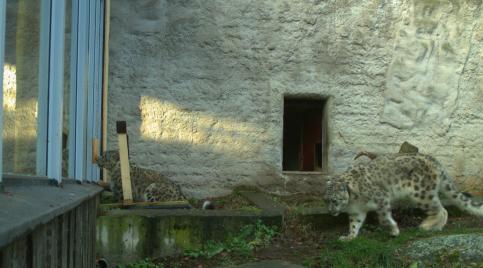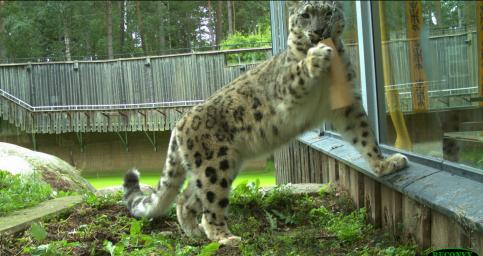Discussion
Bluetooth low energy (BLE)
Using a collar with a Bluetooth tag attached works as an alternative tracking and identification method, instead of using GPS collars. Collars with a Bluetooth tag is lighter than a GPS-collar which means that it does not affect the animals that much and the animals could therefore wear the collars for a longer time. One disadvantage with this method is that the reading range of the application used in the present study is only around 50 metres, and the signal from the tag does not reach the smartphone if the tag is behind a mountain. When using this identification and tracking method in studies on wild snow leopards, several phones with the same application must be used in order to cover a big area in the mountain terrain.
Half-duplex (HDX)

One positive thing about this ID and tracking method is that the uploaded documents are easy to handle. The documents give the ID-number, the time when that specific microchip was detected and for how long that microchip was within the antennas reading range. Since both the antenna and the wildlife camera give the exact second when the microchip was detected, or when the picture was taken, it is easy to find the pictures of the snow leopard and it is also easy to confirm the specific individual, without having to study the pelt patterns so closely. Another positive thing about the HDX-antenna is that it can store a lot of data, so it does not require often uploads. This can be beneficial if the antenna has been installed in a difficult terrain.
However, it does need some improvements before being applied onto wild snow leopards. First, the inbuild clock needs to be fixed because during the study it went too fast. After three days, the clock went around one minute faster than the clock on my smartphone, after two months it went around 45 minutes faster. If the time does not work, this method is quite useless since it is not possible to compare the time from the antenna with the time from the wildlife camera.
Odour enrichment
Active behaviours
The snow leopards performed the behaviour Locomotion significantly more in the cinnamon treatment than in the control treatment. It has been found in studies with odour enrichment that odours increase active behaviour in felines. However, the behaviour Sitting was performed significantly more in the cinnamon and nutmeg treatments, than the control treatment. This makes it questionable if the odours really had an impact on the active behaviours or not. The result of the active behaviours could be explained by the way the odour enrichments were presented. Here, the enrichments were placed in one specific part of the enclosure and could not be removed by the snow leopards. This way was the best way possible in order to both lure the snow leopards to the test site so that the microchips were detected as many times as possible, but also to see which odours the snow leopards showed more interest towards. But, the results might have been different if the odours were presented in another way.

Log behaviours
For the odour enrichment, both snow leopards interacted more with the odour treatments than the control treatment. This result is corresponding to the results of a previous master’s degree project on another snow leopard pair in the same enclosure at Kolmården, where the snow leopards showed more interest towards the odourised objects than the non-odourised objects. It has also been found that both Amur leopards and black-footed cats interacted more with odourised objects, than non-odourised objects. In the present study, both the male and the female snow leopard showed most interest towards lavender. This suggests that lavender could work as enrichment for these two individuals and that lavedender should be tested as enrichment for other snow leopards.
Stereotypic behaviours
Both snow leopards in the present study performed stereotypic behaviours. Pacing was only performed by the female while Scratching window was performed by both snow leopards. In previous studies on felid species, odour enrichment has reduced stereotypic behaviours in jaguars, lions, ocelots, tigers and in Oncilla cats. However, odour enrichment has also shown no significant difference in stereotypic behaviours in Amur leopards and female jaguars. Some odours show a decrease in stereotypic behaviours in some species and sex, while other odours do not show the same effect. In the present study, the behaviour Scratching window was performed more during the cinnamon treatment compard to the lavender treatment. However, it is hard to say if the different trearments had an impact on the stereotypic behaviours since both Pacing and Scratching window was performed before the snow leopards had intearcted with the log.
Conclusions
It can be concluded that both identification and tracking methods worked but they need improvements before they can be applied onto wild snow leopards. Further, the behaviours Locomotion and Scratching window increased with cinnamon in both snow leopards. It can also be concluded that both snow leopards showed most interest towards lavender, which suggests that lavender could work as enrichment for these individuals.
Responsible for this page:
Director of undergraduate studies Biology
Last updated:
05/31/18
